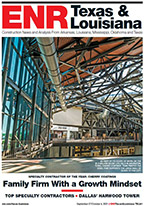Crews also installed more than 16,500 H-piles at lengths ranging from 64 to 166 ft, for a total of about 2.17 million linear ft weighing 111,502 tons placed. Construction of the concrete floodwall required placement of 173,392 cu yd of concrete for the stabilization slabs, base slabs and walls. A bentonite cement slurry mixture was used to fill H-pile voids. Five steel roller gates and one overhead trolley gate were also installed.
Despite the delays, Cajun was able to expedite some site work and materials procurement in advance via the early-contractor-involvement delivery method used by the Corps. LPV 148 was one of five Corps projects in Louisiana to employ the approach.
Still, when work began in earnest in December 2010, the team needed a plan to keep the project on the fast track. Cajun broke the job into five main management areas of more than one mile each. From there, it split the job into a total of 18 work areas. "Each one was treated like its own job," said Todd Grisby, president of Cajun Constructors. "We put a super on each one and a person in charge of all main responsibilities, from materials to safety to production."
Splitting the project into small pieces gave the team better control of the process, says Chris Gilmore, Corps senior project manager. "From a logistical standpoint, it was very impressive," he says. The plan required an added level of management and a significant work force—more than 1,400 workers at peak. Cajun sent out a call for help across the South, bringing in workers from more than a dozen states. The firm also assembled and managed an impressive fleet of heavy equipment on site, including 126 cranes all staffed by certified operators. "Without a doubt, the recession helped us out," Grisby says. "Without the recession, I don't know how we would have pulled that off."
Strong Safety Culture
The combination of speed, lots of equipment and a geographically diverse work force was daunting for Cajun's safety team, says Hurley Henson, Cajun's public works division safety manager. "We knew we'd be faced with the problem of hiring a lot of new employees who knew very little about our safety culture," he says.
To help with the process, Henson brought in 35 safety professionals, requiring them to spend at least 85% of their time in the field. The company hired full-time trainers for the first time, stationing them at the site to help with the constant flow of new employees. Despite the need for speed, Cajun retained a zero-tolerance policy for safety violations. The firm shut down production when necessary.
The plan paid off. Cajun recorded more than 1.5 million man-hours on the job without a lost-time accident. "That showcases an incredibly strong safety culture," Gilmore says. In recognition, the Corps awarded Cajun a 2011 Superior Safety Performance award. Cajun's strong safety culture was also evident last November when its industrial division celebrated three years without a recordable injury. During that time, it finished 196 projects and logged 3.9 million man-hours.
Industrial Opportunities
Cajun's performance record on industrial work has kept the company in good standing with many key owners. Although refinery work slowed a few years ago, the contractor continues to land regular work with major clients such as Chevron at its Pascagoula, Miss., refinery. Last year the contractor started a $45-million project at Valero's Diamond Green Diesel project in Norco, La. "Cajun's team of professionals hit that jobsite running and never looked back," says Stephen Toups, corporate vice president of Turner Industries, the project's general contractor.







Post a comment to this article
Report Abusive Comment